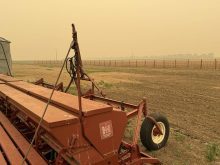Farmers should be looking for wheat midge, entomologists say.
Recent rains have created perfect conditions for the pests.
“In the next two to three weeks we should be seeing a lot of wheat midge emergence,” said Agriculture Canada entomologist Owen Olfert.
The drought conditions of the past month across most of the Prairies have delayed midge outbreaks, Olfert said.
But it didn’t end the threat. Fall midge numbers were high, and the bugs just need the right conditions to emerge and attack wheat crops.
Read Also

Saskatchewan puts crown land auction on hold
Auctions of Saskatchewan crown lease land are once again on hold.
“Don’t go on holidays for three weeks,” advised Olfert.
Wheat is most susceptible to midge attacks when the head starts to emerge from the boot, a maturity level already reached in some fields, while others are close to the boot stage.
In years with more traditional weather, midge outbreaks tend to occur quite uniformly across the grain belt. But this year, drought, heat and rain have been so uneven that crops are at many staggered stages of development, so midge outbreaks will also be varied.
“We’ll probably see a prolonged emergence this year.”
Midge outbreaks are becoming more predictable, Olfert said. Researchers can measure the amount of heat and moisture in soil and forecast when midges will emerge. Heat had already created the right conditions for midges, and the recent rains have added the necessary moisture.















